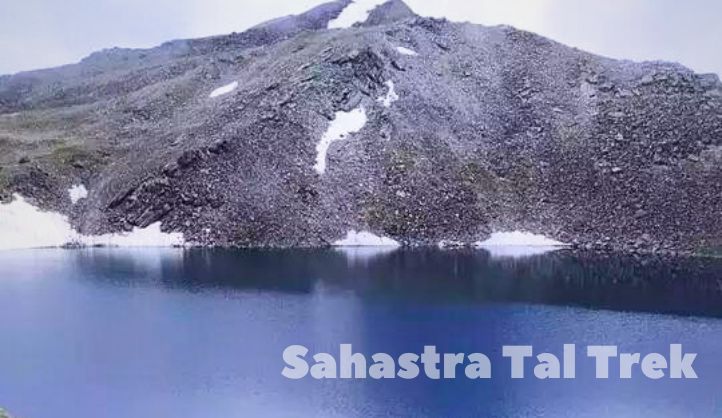The Sahastra Tal trek is a challenging but rewarding 7-day trek in the Uttarkashi district of Uttarakhand, India. The trek takes you through stunning alpine scenery, including snow-capped peaks, glaciers, and crystal-clear lakes. The trek is named after the seven lakes that are located along the route.
Overview Sahastra Tal Trek
The Sahastra Tal trek is a moderate to difficult trek, with an altitude gain of over 10,000 feet (3,000 meters). The trek is best completed during the spring (April-June) or autumn (September-November) months, when the weather is mild.
The trek starts in the town of Bhatwari, which is located about 180 kilometers (112 miles) from Dehradun. The first day of the trek is a short drive to the village of Malla. From Malla, the trek begins in earnest, following a trail that winds through forests and meadows.
On the second day, the trek reaches the village of Gairi, which is the base camp for the trek. Gairi is a small village with a few guesthouses and shops.
The third day of the trek is the longest day of the trek, with a distance of about 15 kilometers (9 miles). The trek ascends to the Kush Kalyan pass, which offers stunning views of the surrounding peaks.
On the fourth day, the trek descends to the village of Jwalapur, which is located at the base of the Sahastra Tal lakes. Jwalapur is a small village with a few guesthouses and shops.
On the fifth day, the trek visits the Sahastra Tal lakes. The lakes are located in a beautiful alpine setting, surrounded by snow-capped peaks.
On the sixth day, the trek ascends to the Chaturangi pass, which offers stunning views of the Gangotri Glacier.
On the seventh day, the trek descends back to Bhatwari.
Itinerary
Here is a suggested itinerary for the Sahastra Tal trek:
Day 1:
- Drive from Dehradun to Bhatwari (175 kilometers, 8-9 hours)
- Arrive in Bhatwari and check in to a guesthouse
Day 2:
- Trek from Malla to Gairi (8 kilometers, 4-5 hours)
- Arrive in Gairi and check in to a guesthouse
Day 3:
- Trek from Gairi to Kush Kalyan (15 kilometers, 8-9 hours)
- Camp at Kush Kalyan
Day 4:
- Trek from Kush Kalyan to Jwalapur (12 kilometers, 6-7 hours)
- Arrive in Jwalapur and check in to a guesthouse
Day 5:
- Trek to the Sahastra Tal lakes (6 kilometers, 3-4 hours)
- Camp near the Sahastra Tal lakes
Day 6:
- Trek to the Chaturangi pass (10 kilometers, 5-6 hours)
- Camp near the Chaturangi pass
Day 7:
- Trek from the Chaturangi pass to Bhatwari (15 kilometers, 8-9 hours)
- Drive back to Dehradun (175 kilometers, 8-9 hours)
Logistics
The Sahastra Tal trek can be completed independently or with a guide. If you are planning to trek independently, you will need to arrange for transportation, accommodation, and permits.
Transportation: The best way to reach the starting point of the trek is by car. There are regular buses from Dehradun to Bhatwari.
Accommodation: There are a few guesthouses and campsites along the route of the trek. It is advisable to book accommodation in advance, especially during the peak season.
Permits: You will need to obtain a trekking permit from the Uttarkashi District Magistrate’s office.
Gear
The following gear is essential for the Sahastra Tal trek:
- Comfortable hiking boots
- Trekking poles
- Hiking backpack
- Sleeping bag
- Tent
- Sleeping pad
- Hiking clothes
- Sunscreen
- Insect repellent
- First-aid kit
Tips
- The Sahastra Tal trek is a moderate to difficult trek, so it is important to be in good physical condition.
- The weather at high altitudes can be unpredictable, so it is important to be prepared for a variety of weather conditions.
- Be sure to drink plenty of water and stay hydrated.
- Altitude sickness can be a problem at high altitudes, so be sure to acclimatize yourself slowly.
- If you are experiencing symptoms of altitude sickness, it is important to descend immediately.
- Be respectful of the local culture and environment.
- Leave no trace of your presence.
Here are some additional tips for planning your Sahastra Tal trek:
- The best time to do the trek is during the spring (April-June) or autumn (September-November) months, when the weather is mild.
- The trek is not suitable for young children or people with health problems.
- The trek is located in a remote area, so be sure to tell someone where you are going and when you expect to return.
- If you are planning to trek independently, be sure to have a good map and compass.
- You can also hire a guide to help you with the trek.
The Sahastra Tal trek is a breathtaking journey through the Garhwal Himalayas, offering a glimpse into the pristine beauty of the Indian wilderness. The trek culminates at the enchanting Sahastra Tal lakes, a cluster of seven glistening lakes nestled amidst snow-capped peaks and verdant meadows.
Trekking Options
The Sahastra Tal trek can be undertaken independently, though it’s recommended to engage a local guide for safety and to gain insights into the region’s rich cultural heritage. Several trekking companies in Uttarkashi organize guided treks to Sahastra Tal, providing logistical support, including transportation, accommodation, equipment rental, and meals.
Route and Duration
The Sahastra Tal trek typically takes 7-8 days to complete, covering approximately 55 kilometers. The trek starts from the village of Bhatwari, located about 180 kilometers from Dehradun, the capital of Uttarakhand. From Bhatwari, the trail ascends through forests, meadows, and alpine grasslands, gradually gaining altitude.
Highlights of the Trek
-
Kush Kalyan Pass: Offering panoramic views of the snow-capped peaks of the Himalayas, including Jaonli, Kedarkanth, and Swargarohini.
-
Jwalapur Village: A charming hamlet with traditional houses and a rustic ambiance, known for its warm hospitality and local handicrafts.
-
Sahastra Tal Lakes: A cluster of seven pristine lakes, each with its unique charm and reflecting the surrounding mountains.
-
Chaturangi Pass: Providing stunning views of the Gangotri Glacier, the source of the mighty Ganges River.
Fitness Level and Preparation
The Sahastra Tal trek is considered moderate to difficult, with an altitude gain of over 3000 meters. It’s essential to be in good physical condition and have prior trekking experience. Regular exercise and acclimatization to high altitudes are crucial for a safe and enjoyable trek.
Essential Gear
The following gear is essential for the Sahastra Tal trek:
- Comfortable hiking boots
- Trekking poles
- Warm clothing
- Waterproof jacket and rain pants
- Sleeping bag and sleeping pad
- Tent or camping gear
- First-aid kit
- Water bottle and purification tablets
- Headlamp or flashlight
- Sunscreen
- Insect repellent
Permits and Regulations
A trekking permit is mandatory for the Sahastra Tal trek. Permits can be obtained from the District Magistrate’s office in Uttarkashi. It’s advisable to apply for the permit well in advance, especially during the peak season.
Responsible Trekking Practices
-
Leave no trace of your presence. Pack out all trash and dispose of it responsibly.
-
Respect the local culture and traditions. Dress modestly and seek permission before entering temples or private properties.
-
Protect the fragile Himalayan ecosystem. Avoid disturbing wildlife and vegetation.
-
Minimize water usage and use biodegradable toiletries.
-
Support local communities by purchasing local handicrafts and produce.
Additional Tips
-
Start the trek early in the day to avoid the afternoon heat and potential thunderstorms.
-
Acclimatize gradually to high altitudes to prevent altitude sickness.
-
Stay hydrated by drinking plenty of water and electrolyte-rich beverages.
-
Be mindful of your surroundings and avoid venturing off the established trail.
-
Report any injuries or emergencies to the local authorities or your trekking guide promptly.
-
Respect the natural beauty of the Himalayas and leave the environment pristine for future generations to enjoy.
Conclusion:
In conclusion, the Sahastra Tal Trek offers a breathtaking adventure for nature enthusiasts and avid trekkers alike. Nestled in the heart of the Himalayas, this trek is a captivating journey through diverse landscapes, from lush green meadows to snow-clad peaks. The pristine beauty of Sahastra Tal, a high-altitude glacial lake, is a reward for the challenging yet exhilarating trek.
As trekkers traverse through dense forests, alpine meadows, and rocky terrains, they are treated to panoramic views of towering peaks and the serenity of high-altitude ecosystems. The trek not only tests one’s physical endurance but also provides moments of introspection and connection with nature.
FAQs (Frequently Asked Questions):
What is the best time to undertake the Sahastra Tal Trek?
The ideal time for the Sahastra Tal Trek is during the summer months, from May to June, and post-monsoon season, from September to October. During these periods, the weather is relatively stable, and the landscapes are at their vibrant best.
How difficult is the Sahastra Tal Trek?
The trek is graded as moderate to difficult, requiring a good level of physical fitness. Trekkers should be prepared for steep ascents, rocky terrains, and varying weather conditions. Prior trekking experience is recommended.
What permits are required for the trek?
Trekkers need to obtain permits from the local authorities, and it’s advisable to check the latest regulations before planning the trek. It is also recommended to hire a registered guide to ensure a smooth and regulated trekking experience.
Are there accommodation facilities during the trek?
Accommodation during the trek is generally in tents at designated campsites. Trekkers need to carry their own sleeping bags and other personal camping gear. It’s essential to be well-prepared for the camping experience at high altitudes.
Is it necessary to hire a guide for the Sahastra Tal Trek?
While it’s not mandatory, hiring a local guide is highly recommended for safety and navigation. Experienced guides are familiar with the terrain, weather conditions, and can enhance the overall trekking experience.





